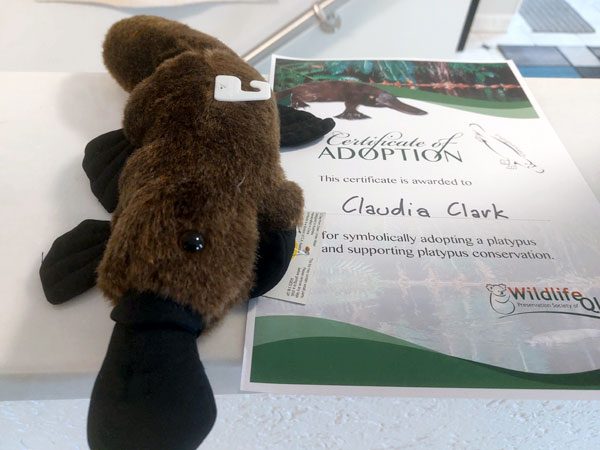One of the best things about writing this book is learning new and interesting facts about animals of which I had no previous knowledge. One of these animals is the platypus or the duck-billed platypus. This animal fascinated me so much that I asked Brian to adopt a platypus for my birthday rather than another koala or kangaroo. These unique animals are so mysterious that after the first British settlers sent drawings of the newly discovered animals to England, the British scientists thought they were a joke. Given that the platypus has fur similar to an otter’s, a tail like a beaver’s, and a bill and webbed feet similar to a duck’s, it is unsurprising that Europeans found this animal too strange to legitimate. Nevertheless, after scrutiny, scientists learned this unique creature to be legitimate. However, it took them over one hundred years to learn the full complexities of this animal—in addition to all its other idiosyncrasies, they also lay eggs. Yes, in fact, there is a mammal on the planet that actually lays eggs. These animals live in the eastern part of Australia in Queensland and the southern island of Tasmania. Unfortunately, like many of Australia’s endemic animals, they are endangered due to land clearing, climate change, drought, and water extraction. These animals are protected by law in every region which they inhabit. Due to the interesting characteristics these animals possess, rather than write a long narrative that will be found in the book, I decided to change things a bit for the blog and highlight what I call the “Fun Facts” about these creatures. After reading this, I hope people will become as fascinated as I am.
TEN FUN FACTS ABOUT THE PLATYPUS
A baby platypus is called a puggle
The platypus has five pairs of chromosomes, which determine the sex
The male is venomous during mating season, and while it is not deadly to humans, it is painful enough that traditional medication like morphine does nothing to ease the pain of the sting. Scientists believe their vermin can be beneficial in finding a treatment for diabetes in humans.
The female has two ovaries and only the left one functions.
Other than during the mating season, these animals are solitary and shy animals
They are carnivorous or meat-eating animals that primarily eat invertebrates such as swimming beetles, tadpoles, worms, snails, shrimp, and insect larvae
A group of platypuses is called a paddle, named after the shape of their tails
When placed under UV lights, they give off a biofluorescent green-blue glow
Instead of teeth, adult platypuses have grinding pads in their jaws to help them eat.
Rather than the typical nipple most mammals have, milk seeps directly out of the female’s mammary gland and collects in grooves on her skin, where her puggles lap it or suck it out of her fur.


Recent Comments